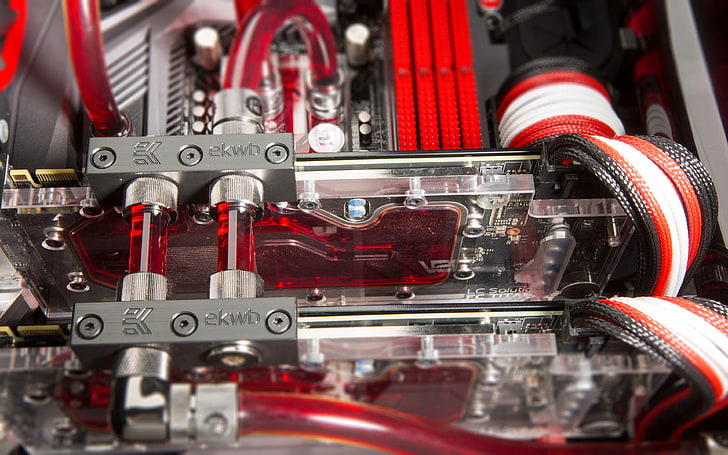pc g is not just a hobby; it’s a vibrant community that offers endless possibilities for gamers and tech enthusiasts alike. This exploration into the world of PC gaming begins with the foundational elements required to build a high-performance gaming rig, from essential components to the latest graphics cards that can take your gaming experience to the next level.
As we dive deeper, we will uncover the latest trends shaping the gaming landscape, including the surge in virtual reality and the transformative impact of cloud gaming on traditional setups. Understanding the importance of quality cooling systems and optimization techniques will also be crucial as we discuss how to ensure your gaming setup runs smoothly and efficiently.
PC Gaming Basics

Building a gaming PC can be an exciting yet daunting experience for newcomers. Understanding the essential components and their roles is crucial in creating a system that meets your gaming needs. From the motherboard to the graphics card, each part plays a significant role in determining performance and overall gaming experience.
Essential Components for Building a Gaming PC
A well-rounded gaming PC consists of several key components that work together to deliver high-quality performance. Below are the primary parts needed to assemble a gaming rig:
- Central Processing Unit (CPU): The brain of the computer, responsible for executing instructions. Popular gaming CPUs include AMD Ryzen and Intel Core series, which provide excellent performance in gaming and multitasking.
- Graphics Processing Unit (GPU): The heart of gaming performance, responsible for rendering images and video. High-end options like NVIDIA GeForce RTX and AMD Radeon RX series are excellent choices for gamers seeking top-tier graphics.
- Motherboard: The main circuit board that connects all components. Choosing a compatible motherboard with the right chipset and features is essential for maximizing performance and connectivity.
- Memory (RAM): Temporary storage that allows your CPU to access data quickly. For gaming, a minimum of 16GB RAM is recommended, while 32GB is preferred for high-performance setups.
- Storage Drives: Solid State Drives (SSDs) provide fast load times and responsiveness, while Hard Disk Drives (HDDs) offer larger storage capacity for games. A combination of both is often the best approach.
- Power Supply Unit (PSU): Supplies power to all components. A reliable PSU with sufficient wattage is critical for system stability.
- Case: Houses all components and provides airflow. Choosing a well-ventilated case is crucial for maintaining optimal temperatures during gaming sessions.
- Cooling System: Essential for preventing overheating in high-performance builds. Options include air coolers, all-in-one (AIO) liquid coolers, and custom water cooling setups.
Comparison of Different Graphics Cards for Gaming
Selecting the right graphics card can significantly impact gaming performance. Here’s a detailed comparison of some top graphics cards currently available:
| Graphics Card | Performance | VRAM | Price (Approx.) |
|---|---|---|---|
| NVIDIA GeForce RTX 4090 | Exceptional for 4K gaming, high frame rates | 24GB GDDR6X | $1,599 |
| AMD Radeon RX 7900 XTX | Great for 1440p, competitive in 4K | 24GB GDDR6 | $999 |
| NVIDIA GeForce RTX 3080 | Excellent for 1440p, strong 4K capability | 10GB GDDR6X | $699 |
| AMD Radeon RX 6800 XT | Strong 1440p performance, good 4K | 16GB GDDR6 | $649 |
Each card is suited for different gaming resolutions and performance expectations. The NVIDIA GeForce RTX 4090 leads the pack with unmatched performance at a premium price, while the AMD Radeon RX 7900 XTX offers a competitive option for serious gamers without breaking the bank.
Importance of Cooling Systems in High-Performance Gaming PCs
Cooling systems are vital in maintaining optimal temperatures in gaming PCs, especially those with high-performance components. Overheating can lead to thermal throttling, reducing performance, and potentially damaging components.
Cooling solutions can be categorized into two main types: air cooling and liquid cooling.
- Air Cooling: Utilizes heatsinks and fans to dissipate heat. It is generally more affordable and easier to install. High-quality air coolers can effectively manage temperatures in moderate builds.
- Liquid Cooling: Uses a liquid coolant to transfer heat away from components. While typically more expensive and complex to install, liquid cooling can provide superior thermal performance, especially for overclocked CPUs and GPUs.
Installing an efficient cooling system not only enhances performance but also extends the lifespan of the components. High-performance gaming systems, particularly those used for extended sessions, benefit greatly from robust cooling solutions to ensure reliability and peak operation.
Gaming Trends

The landscape of PC gaming is constantly evolving, driven by advancements in technology, shifts in consumer preferences, and the emergence of new genres. Currently, several key trends are shaping the future of PC gaming, from hardware innovations to the integration of virtual reality and the effects of cloud gaming on traditional setups. Understanding these trends can help gamers make informed decisions about their equipment and gaming experiences.
Latest Trends in PC Gaming Hardware and Accessories
The PC gaming hardware market is witnessing rapid advancements that enhance performance, improve user experience, and provide more immersive gameplay. Noteworthy trends include the rise of high-refresh-rate monitors, cutting-edge GPUs, and customizable RGB lighting. Gamers are increasingly focusing on equipment that not only performs well but also enhances their overall aesthetic.
- High-Refresh-Rate Displays: Monitors with refresh rates of 144Hz and above are becoming standard, offering smoother visuals and reducing motion blur for competitive gaming.
- Next-Gen GPUs: Graphics cards like NVIDIA’s RTX 30 series and AMD’s RX 6000 series deliver exceptional performance and support for real-time ray tracing, making games visually stunning.
- Ergonomic Accessories: Gaming mice, keyboards, and chairs designed for comfort and long hours of play are gaining traction, emphasizing the importance of ergonomics in gaming setups.
- Modular Gaming PCs: Pre-built gaming PCs are increasingly featuring modular components, allowing gamers to easily upgrade parts as technology advances.
Growing Popularity of VR in the PC Gaming Community
Virtual reality gaming has carved out a niche within the PC gaming community, offering immersive experiences that traditional gaming setups cannot match. As VR technology matures, more players are investing in VR headsets, which enhances gameplay through a sense of presence and interaction.
- Advanced VR Headsets: Devices like the Oculus Quest 2 and Valve Index provide higher resolutions and better tracking, making VR experiences more engaging.
- Diverse Game Library: A growing number of VR titles, ranging from action-packed adventures to simulation games, cater to various interests and skill levels.
- Social VR Experiences: Multiplayer VR games and social platforms allow players to connect and interact in virtual spaces, enhancing the communal aspect of gaming.
- Increased Accessibility: As VR technology becomes more affordable, a wider audience can access immersive experiences, contributing to the growth of the VR gaming market.
Impact of Cloud Gaming on Traditional PC Gaming Setups
Cloud gaming is reshaping traditional notions of gaming hardware and accessibility. By allowing gamers to stream high-quality games without the need for powerful local hardware, cloud gaming platforms are democratizing gaming experiences.
- Reduced Hardware Requirements: With cloud gaming services like Google Stadia and NVIDIA GeForce Now, players can enjoy graphically intensive games on less powerful devices, broadening access.
- Flexibility and Convenience: Gamers can play their favorite titles across multiple devices without the need for extensive setups, facilitating gaming on the go.
- Subscription Models: The rise of subscription-based services offers gamers access to a broader library of titles, changing the way games are purchased and consumed.
- Potential Challenges for Traditional PCs: The growth of cloud gaming may influence the demand for high-end gaming PCs, as some gamers may shift their focus to streaming solutions.
Optimization Techniques

Optimizing your gaming PC is crucial for enhancing performance and ensuring a smooth gaming experience. This involves fine-tuning settings, making hardware adjustments, and regular maintenance. The right optimization techniques can help you achieve higher frame rates, better graphics, and an overall improved gameplay environment.
Settings and Adjustments for Enhanced Performance
To maximize gaming performance, various settings and adjustments can be made across your operating system and game settings. Here are some critical areas to consider:
– Graphics Settings:
Adjusting in-game graphics settings can have a significant impact on performance. Lowering settings like shadows, textures, and anti-aliasing can boost frame rates.
– Resolution:
Reducing the resolution can improve performance, especially on older hardware. A lower resolution requires less processing power, resulting in higher frame rates.
– V-Sync:
Disabling V-Sync can reduce input lag and improve responsiveness but may lead to screen tearing. Finding the right balance based on your hardware is essential.
– Game Mode:
Activating Game Mode in Windows can help prioritize gaming performance by limiting background processes, ensuring more resources are allocated to the game.
– Background Applications:
Closing unnecessary applications running in the background can free up system resources. Use the Task Manager to identify and terminate these processes.
Step-by-Step Guide to Overclocking a CPU
Overclocking your CPU can lead to improved gaming performance by increasing processing speed. Here’s a systematic approach to safely overclock your CPU:
1. Research Compatibility:
Ensure your CPU and motherboard support overclocking. Models like Intel’s K-series or AMD’s unlocked CPUs are ideal.
2. Install Monitoring Software:
Use software like CPU-Z or HWMonitor to keep track of your CPU’s temperature and performance metrics during overclocking.
3. Enter BIOS:
Restart your PC and enter the BIOS by pressing the designated key (usually DEL or F2) during boot.
4. Increase Multiplier/Clock Speed:
Locate the CPU multiplier setting in the BIOS. Incrementally increase this value, ensuring not to exceed manufacturer specifications.
5. Adjust Voltage:
If stability issues arise, increase the CPU voltage (vCore) slightly. Be cautious, as excessive voltage can damage the CPU.
6. Test Stability:
Boot into Windows and run stress-testing software (like Prime95 or AIDA64) to check for stability and monitor temperatures.
7. Fine-tune Settings:
If stable, continue adjusting the multiplier or voltage in small increments, testing for stability after each change.
8. Cooling Solutions:
Ensure you have adequate cooling. Consider upgrading to a higher-end aftermarket cooler if temperatures exceed safe limits.
Optimal CPU temperatures should generally stay below 85°C during heavy loads.
Best Practices for Maintaining and Cleaning a Gaming PC
Regular maintenance and cleaning are vital for extending the lifespan of your gaming PC. Here are some recommended practices:
– Dust Removal:
Dust accumulation can lead to overheating. Regularly clean the interior of your PC using compressed air to blow out dust from components and fans.
– Cable Management:
Organizing cables can improve airflow and reduce clutter. Use zip ties or cable sleeves to keep everything neat.
– Thermal Paste Replacement:
Over time, thermal paste can degrade, reducing heat transfer between the CPU/GPU and their coolers. Consider replacing it every couple of years.
– Regular Software Updates:
Keep your operating system, drivers, and games up to date to benefit from performance improvements and bug fixes.
– Check for Malware:
Run regular antivirus scans to ensure your system is free from malware that can hinder performance.
By implementing these optimization techniques, you can significantly enhance your gaming experience, ensuring that your PC maintains peak performance for years to come.

